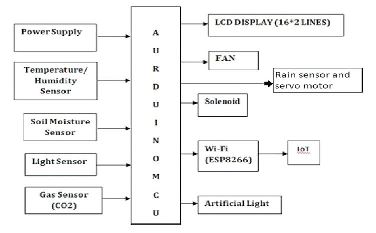Abstract
Greenhouse technology is a way to improve crop production. Technology has advanced swiftly in the fields of agriculture and food production and is still paving the way for the optimization and achievement of maximum plant growth. In the current age of Android smartphone applications, a precise mechanism would undoubtedly bring about change. The Internet of Things (IoT) is one of the latest achievements in the field of information and communication technologies, providing global communication and control of sensors, devices, and users with information. This paper proposes a greenhouse monitoring and control system using IoT. The temperature sensor, air quality sensor, soil moisture sensor, Light Dependent Resistors (LDR) sensor, Liquid-Crystal Display (LCD) module, 12-volt Direct Current (DC) fan, electric bulb, water pump motor, and the servo motor with the Internet of Things (IoT) technology make up this greenhouse's monitoring and control system to measure nitrous oxide, temperature, humidity, illumination, CO2, and irrigation to create a plant-friendly atmosphere. The farmers may use the IoT platform to receive the collected environmental parameter data to their smartphones in online mode so they can make the correct decisions without visiting the field.
Keywords:
- Greenhouse
- IoT
- Sensors
- Arduino UNO
Introduction
One of the biggest problems facing humanity in the 21st century is food shortages. Most of the land available forgrowing crops will be lost to climate change, and other weather-related factors can be controlled through signal processing applications and biomedical applications (Bharathi et al., 2022a). Greenhouse gases reabsorb heat energy from the earth's surface and redirect it in all directions. As a result, there are many unfavorable effects that affect how long the planet can sustain itself. Li et al. (2014) focus mainly on food shortages in which humanity is facing major problem. Most of the land available for growing crops is lost due to climate change and other weather-related factors. These problems can be controlled through signal processing applications and biomedical applications. The long-standing greenhouse cultivation practices are now being improved and applied in different parts of the world. Many poor countries have not yet embraced this technology for plant field and strength, which are becoming increasingly important parameters, whether for food or crops, so plant development has become an innovative test and can be seen in images via cloud computing. Lack of knowledge and understanding of agricultural details and new technological innovations is one of the major problems in agriculture. The ancestors avoided using developments specialized in growing specific crops in their ancient agribusiness systems, instead used miracles common to all crops. Technology for food production is increasingly in demand. Long, scorching summers and moderate winters are the fundamental characteristics of the summer and winter climates, respectively. Such environmental factors significantly limit the varieties of crops that can be successfully cultivated. It also comes with many other problems similar to this. To find a solution to this problems such as extreme heat, humidity, light, temperature, pests, and diseases, it is mandatory to have irrigation to provide water (Venkatakrishnamoorthy and Reddy, 2019). To increase productivity, farmers have used various irrigation techniques including human participation. However, plants may use more water, or water may reach them more slowly in various regions. Technological advances in agriculture may develop, resulting in plants growing under unusually normal natural conditions, increasing yields, and decreasing compost production. The precision of agriculture is popular in the development of greenhouse crops because of its inexpensive improvements for farmers to increase production and protect from extreme heat and cold, dust storms, and pests kept out by greenhouses. Modern greenhouse technology and automation in agriculture are already implanted in real-time applications (Dharani et al., 2022).
1. Literature Survey
Floreano and Wood (2015) proposed an embedded Internet of Things (IoT)-based drone that collects data from distributed sensors and activates actuators connected via simple one-wire local area network. The web servers were connected to the Internet through Ethernet or dial-up networking. It is believed that the built system has all the advantages of Network Embedded System Technology (NEST), such as the ability to change physical topology and the lower cost and smaller dimensions compared to a Personal Computer (PC)- based system while maintaining full functionality. Bareth et al. (2015) proposed low-weight, Unmanned Aerial Vehicle (UAV)-based hyper-spectral full-frame cameras and sensors for monitoring crops in greenhouses to control temperature and humidity concentration. (Dharani and Sreenivasulu (2021) proposed various IoT devices in real-time applications for effective monitoring of health conditions and ease of use. With a better understanding of environmental conditions, farmers may be able to apply different techniques to increase yields. A high-frequency module and an application-specific sensor are integrated into the system. All measured parameters are transmitted to the cellular device for analysis via wireless connection. Since this system is used by farmers, energy management is important and mobile phones are used instead of PC terminals. Artificial Intelligence (AI)-based sensors are also used to capture the large area network (forest area and urban area) to monitor temperature and area changes for various applications. Shenan et al. (2017) implemented a greenhouse prototype that integrated with the Internet of Things to allow for remote system parameter adjustment and system status monitoring. The Internet of Things has been utilized to generate a variety of applications. Quynh et al. (2015) suggest a Multipath Routing Protocol for Low-Power and Lossy Networks (RPL) protocol for greenhouse environment monitoring systems based on the Internet of Things, which is useful for forecasting environmental conditions. Pingale and Shinde (2021) implemented a routing protocol based on the sunflower-based Grey Wolf Optimization (SFG) method. Simulation, IoT simulation, and multiprocessor routing operations can all be performed concurrently in this process. Based on context awareness, network lifespan, residual energy, trust, and delay, the SFG algorithm chooses the optimal option among the multipath available for routing.
2. Proposed System
IoT is used in various applications in real-time applications such as the medical field, remote sensing and data communication, etc (Bharathi et al., 2022b). To establish an environment that is favorable for plant growth, climate control systems utilize specialized sensors to measure levels of nitrous oxide, temperature, humidity, lighting, carbon dioxide (CO2), and irrigation (Schulze et al., 2009). An automatic control circuit can be used to control fans for cooling and heating, irrigation, humidity, and lighting ratio. In response to variations in CO and other crop-specific sensors, greenhouse windows open and close. On the Ubidot screen, parameter values continuously show changes in greenhouse parameters. After activating, the farming parameters were notified about the changes.
Figure 1 shows the block diagram of the greenhouse monitoring and control system. It consists of an Arduino UNO microcomputer unit, a temperature and humidity sensor, a soil moisture sensor, an LDR sensor, a gas sensor, a rain sensor, Wi-Fi (ESP8266), a light bulb, a fan, a solenoid, a servo motor. When the temperature exceeds 32 degrees, the temperature sensor will detect it and turn on the fan. When the temperature drops below 32 degrees, the fan will turn off. If the soil moisture sensor detects a water level below 50, water will continue to be pumped. LDR sensors detect the amount of light present. Light is detected and turned on when the light intensity drops below 50 units. When carbon dioxide (Co2) levels in the greenhouse rise, an air quality sensor detects this and alerts the Arduino (Chuah et al., 2019). In this way, the system can be easily controlled and monitored. Precipitation is detected by a rain sensor, and a servo motor is activated (the rotation angle can be set manually if desired). The Node Micro Controller Unit (NodeMCU) module connects to a wireless internet connection via Hypertext Transfer Protocol (HTTP) protocol recognition or IoT platforms such as ubidots.com. No matter how far the farmer, can send the collected environmental parameter data to their smartphone in online mode through an IoT platform so that the field can be properly surveyed (Singh, 2019).
Figure 1. Block Diagram of Greenhouse Monitoring Systems.
3. Results
Unexpected rainfall and sudden increases in soil temperature are currently destroying whole crops, resulting in food shortages and huge economic losses for farmers. Therefore, building a greenhouse monitoring and control system can reduce losses. The structure of a greenhouse monitoring and control system is generally shown in Figure 2. Temperature and humidity, soil moisture, gas, rain, WiFi (ESP8266), light bulb, fan, solenoid, and servo motor sensors are coupled to an Arduino UNO microcontroller unit.

Figure 2. Greenhouse Monitoring and Control System.
Figure 3 shows the condition where the sunlight is OK and the lights have not been switched ON. Figure 4 shows that when the light intensity drops below 50 units, it senses and switches on the light.
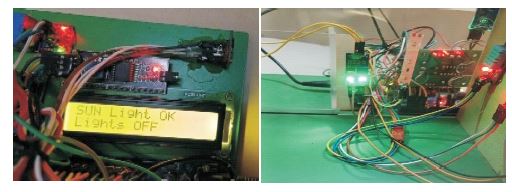
Figure 3. Working of LDR Sensor when Sunlight is ok.
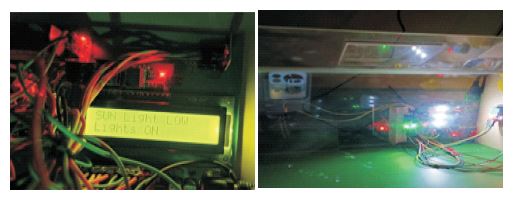
Figure 4. Working of LDR Sensor When Sunlight is Low.
Figure 5 shows that the temperature is 32 degrees and the humidity values are above the threshold, so the fan is OFF.
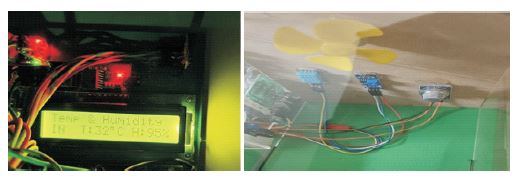
Figure 5. Temperature and Humidity Values and Working of DC Fan.
A soil moisture sensor senses the water level. The threshold moisture levels can be adjusted manually as per the requirement for the crop. Figures 6(a) to 6(c) depict a situation in which the moisture levels are high, resulting in the output soil is wet and the motor is turned OFF. The rain sensor senses the rainfall, and the servo motor changes its angle of rotation accordingly
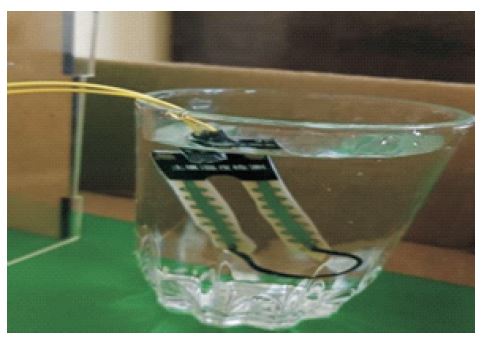
(a)
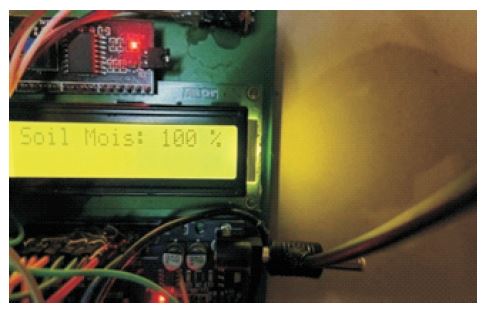
(b)
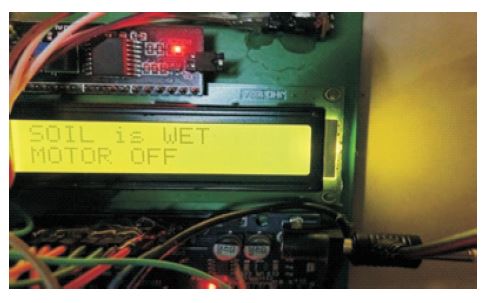
(c)
Figure 6. Soil Moisture Sensor (a) Moist Sensor (b) Soil Moist Percentage (c) Soil Moist Status is Displayed
Figure 7 shows the condition where there is no rainfall and the servo motor is OFF.
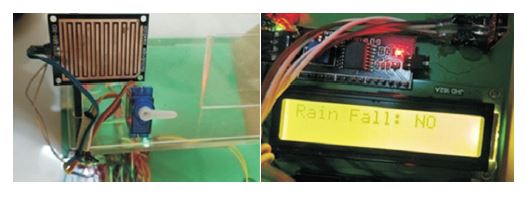
Figure 7. Rain Sensor Working when there is No Rainfall.
Figure 8 shows the condition where there is rainfall and the servo motor is rotated to 90 degrees. Figure 9 shows the air quality sensor that senses the amount of carbon dioxide and gives the overall value of air quality.
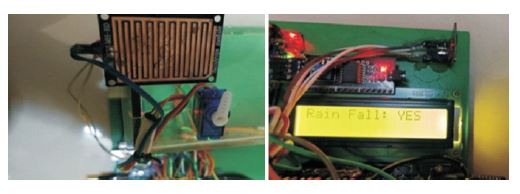
Figure 8. Rain Sensor Working when there is Rainfall.
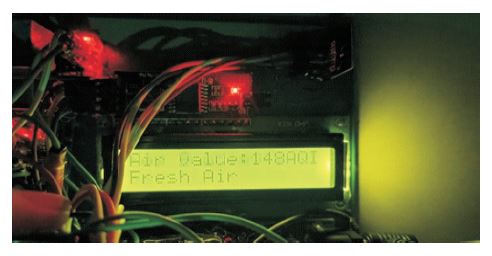
Figure 9. Air Quality Values from Air Quality Sensor.
Conclusion
Internet of Things (IoT) is widely used to connect devices and collect data. The device remotely monitors greenhouse conditions such as CO2, soil moisture, temperature, and light. Farmers can collect this data with the help of cloud accounts and internet connections. Greenhouse windows and doors automatically turn on and off depending on CO2 levels. Using IoT to keep accurate settings in greenhouses, helps farmers increase productivity and avoid field visits.
Future Scope
In many parts of the world, computers and telecommunications technology are not yet widely used for agricultural applications. These locations are gradually expanding the amount of high-speed mobile and internet bandwidth available locally. This paper describes the relevance of the Internet of Things (IoT), which has the potential to revolutionize agriculture and farming practices.
